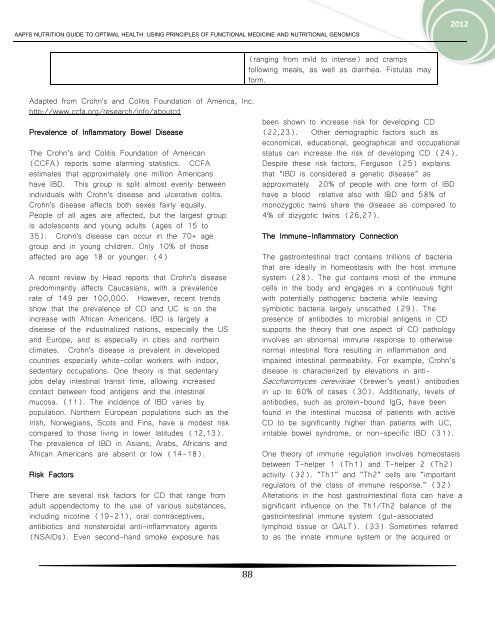functional medicine and nutritional genomics - American Association ...
functional medicine and nutritional genomics - American Association ...
functional medicine and nutritional genomics - American Association ...
Create successful ePaper yourself
Turn your PDF publications into a flip-book with our unique Google optimized e-Paper software.
AAPI’S NUTRITION GUIDE TO OPTIMAL HEALTH: USING PRINCIPLES OF FUNCTIONAL MEDICINE AND NUTRITIONAL GENOMICS<br />
Adapted from Crohn's <strong>and</strong> Colitis Foundation of America, Inc.<br />
http://www.ccfa.org/research/info/aboutcd<br />
Prevalence of Inflammatory Bowel Disease<br />
The Crohn’s <strong>and</strong> Colitis Foundation of <strong>American</strong><br />
(CCFA) reports some alarming statistics. CCFA<br />
estimates that approximately one million <strong>American</strong>s<br />
have IBD. This group is split almost evenly between<br />
individuals with Crohn's disease <strong>and</strong> ulcerative colitis.<br />
Crohn's disease affects both sexes fairly equally.<br />
People of all ages are affected, but the largest group<br />
is adolescents <strong>and</strong> young adults (ages of 15 to<br />
35). Crohn's disease can occur in the 70+ age<br />
group <strong>and</strong> in young children. Only 10% of those<br />
affected are age 18 or younger. (4)<br />
A recent review by Head reports that Crohn's disease<br />
predominantly affects Caucasians, with a prevalence<br />
rate of 149 per 100,000. However, recent trends<br />
show that the prevalence of CD <strong>and</strong> UC is on the<br />
increase with African <strong>American</strong>s. IBD is largely a<br />
disease of the industrialized nations, especially the US<br />
<strong>and</strong> Europe, <strong>and</strong> is especially in cities <strong>and</strong> northern<br />
climates. Crohn's disease is prevalent in developed<br />
countries especially white-collar workers with indoor,<br />
sedentary occupations. One theory is that sedentary<br />
jobs delay intestinal transit time, allowing increased<br />
contact between food antigens <strong>and</strong> the intestinal<br />
mucosa. (11). The incidence of IBD varies by<br />
population. Northern European populations such as the<br />
Irish, Norwegians, Scots <strong>and</strong> Fins, have a modest risk<br />
compared to those living in lower latitudes (12,13).<br />
The prevalence of IBD in Asians, Arabs, Africans <strong>and</strong><br />
African <strong>American</strong>s are absent or low (14-18).<br />
Risk Factors<br />
There are several risk factors for CD that range from<br />
adult appendectomy to the use of various substances,<br />
including nicotine (19-21), oral contraceptives,<br />
antibiotics <strong>and</strong> nonsteroidal anti-inflammatory agents<br />
(NSAIDs). Even second-h<strong>and</strong> smoke exposure has<br />
(ranging from mild to intense) <strong>and</strong> cramps<br />
following meals, as well as diarrhea. Fistulas may<br />
form.<br />
88<br />
2012<br />
been shown to increase risk for developing CD<br />
(22,23). Other demographic factors such as<br />
economical, educational, geographical <strong>and</strong> occupational<br />
status can increase the risk of developing CD (24).<br />
Despite these risk factors, Ferguson (25) explains<br />
that ‚IBD is considered a genetic disease‛ as<br />
approximately 20% of people with one form of IBD<br />
have a blood relative also with IBD <strong>and</strong> 58% of<br />
monozygotic twins share the disease as compared to<br />
4% of dizygotic twins (26,27).<br />
The Immune-Inflammatory Connection<br />
The gastrointestinal tract contains trillions of bacteria<br />
that are ideally in homeostasis with the host immune<br />
system (28). The gut contains most of the immune<br />
cells in the body <strong>and</strong> engages in a continuous fight<br />
with potentially pathogenic bacteria while leaving<br />
symbiotic bacteria largely unscathed (29). The<br />
presence of antibodies to microbial antigens in CD<br />
supports the theory that one aspect of CD pathology<br />
involves an abnormal immune response to otherwise<br />
normal intestinal flora resulting in inflammation <strong>and</strong><br />
impaired intestinal permeability. For example, Crohn’s<br />
disease is characterized by elevations in anti-<br />
Saccharomyces cerevisiae (brewer’s yeast) antibodies<br />
in up to 60% of cases (30). Additionally, levels of<br />
antibodies, such as protein-bound IgG, have been<br />
found in the intestinal mucosa of patients with active<br />
CD to be significantly higher than patients with UC,<br />
irritable bowel syndrome, or non-specific IBD (31).<br />
One theory of immune regulation involves homeostasis<br />
between T-helper 1 (Th1) <strong>and</strong> T-helper 2 (Th2)<br />
activity (32). "Th1" <strong>and</strong> "Th2" cells are "important<br />
regulators of the class of immune response." (32)<br />
Alterations in the host gastrointestinal flora can have a<br />
significant influence on the Th1/Th2 balance of the<br />
gastrointestinal immune system (gut-associated<br />
lymphoid tissue or GALT). (33) Sometimes referred<br />
to as the innate immune system or the acquired or

















